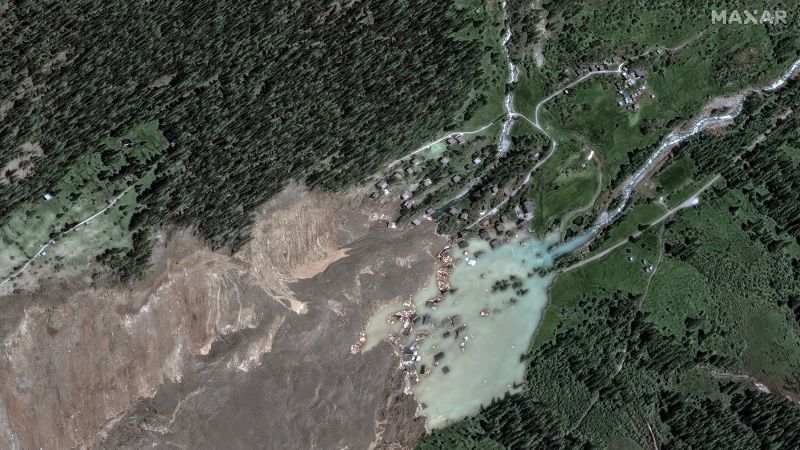California Tsunami Threat: Predicting The Areas At Highest Risk

Welcome to your ultimate source for breaking news, trending updates, and in-depth stories from around the world. Whether it's politics, technology, entertainment, sports, or lifestyle, we bring you real-time updates that keep you informed and ahead of the curve.
Our team works tirelessly to ensure you never miss a moment. From the latest developments in global events to the most talked-about topics on social media, our news platform is designed to deliver accurate and timely information, all in one place.
Stay in the know and join thousands of readers who trust us for reliable, up-to-date content. Explore our expertly curated articles and dive deeper into the stories that matter to you. Visit Best Website now and be part of the conversation. Don't miss out on the headlines that shape our world!
Table of Contents
California Tsunami Threat: Predicting the Areas at Highest Risk
California's stunning coastline, while breathtakingly beautiful, harbors a significant, often overlooked danger: tsunamis. While the Pacific Northwest often grabs headlines regarding earthquake-related tsunami risks, California faces a substantial threat, demanding preparedness and understanding. This article delves into the areas most vulnerable to tsunami damage in California, exploring the science behind prediction and the crucial role of early warning systems.
Understanding California's Tsunami Risk
California's vulnerability stems from its proximity to major tectonic plate boundaries, the same forces responsible for the state's frequent earthquakes. A significant earthquake, particularly a subduction zone earthquake off the coast of Alaska, the Pacific Northwest, or even a closer, less powerful event, can generate tsunamis capable of impacting California's shores. Unlike hurricanes, which offer valuable warning time, tsunamis can arrive with little to no advance notice, making preparedness paramount.
Areas at Highest Risk:
Several factors determine a region's tsunami risk: proximity to the source, bathymetry (ocean floor shape), and coastal geography. Based on these factors, some California areas face significantly higher risks than others:
-
Northern California: Areas along the Mendocino Coast, Humboldt County, and Crescent City are particularly vulnerable due to their proximity to the Cascadia Subduction Zone. A large Cascadia earthquake could generate a devastating tsunami impacting these regions within minutes.
-
Southern California: While generally perceived as less at risk than Northern California, Southern California isn't immune. A large earthquake along the San Andreas Fault or other regional faults could trigger a local tsunami. Coastal communities in Los Angeles, San Diego, and Orange Counties should have robust evacuation plans.
-
Bay Area: The San Francisco Bay Area's complex geography presents a unique challenge. While the bay itself offers some protection, certain areas, particularly those with narrow inlets and shallow waters, could experience significant wave amplification.
Predicting the Unpredictable: Tsunami Early Warning Systems
The National Oceanic and Atmospheric Administration (NOAA) operates a sophisticated tsunami warning system, using a network of seismic sensors, buoys, and tide gauges to detect and track tsunamis. This system provides vital warning time, allowing for evacuations and other emergency measures. However, the speed of a tsunami requires rapid response; even minutes of warning can be life-saving.
What You Can Do:
Understanding your risk is the first step to effective preparation. Here's what you can do:
- Know your evacuation zone: Visit the NOAA website or your local emergency management agency to determine your tsunami evacuation zone.
- Develop an evacuation plan: Plan your escape routes and designate a meeting place. Practice your plan regularly.
- Build an emergency kit: Stock up on essential supplies, including water, food, first-aid kit, and flashlights.
- Stay informed: Monitor NOAA weather alerts and your local news for tsunami warnings.
Conclusion:
While the possibility of a major tsunami striking California is real, understanding the risks and having a preparedness plan significantly increases your chances of survival. Stay informed, plan ahead, and remember that preparedness is the best defense against this formidable natural hazard. Learn more about tsunami safety by visiting the . Your safety depends on it.

Thank you for visiting our website, your trusted source for the latest updates and in-depth coverage on California Tsunami Threat: Predicting The Areas At Highest Risk. We're committed to keeping you informed with timely and accurate information to meet your curiosity and needs.
If you have any questions, suggestions, or feedback, we'd love to hear from you. Your insights are valuable to us and help us improve to serve you better. Feel free to reach out through our contact page.
Don't forget to bookmark our website and check back regularly for the latest headlines and trending topics. See you next time, and thank you for being part of our growing community!
Featured Posts
-
 How Two Tynemouth Surfing Brothers Escaped A Terrifying Rip Current
Jun 09, 2025
How Two Tynemouth Surfing Brothers Escaped A Terrifying Rip Current
Jun 09, 2025 -
 Actress Dawn Frenchs Gaza Video Sparks Outrage And Apology
Jun 09, 2025
Actress Dawn Frenchs Gaza Video Sparks Outrage And Apology
Jun 09, 2025 -
 Unlock Your Bodys Natural Clock 4 Effective Circadian Rhythm Hacks
Jun 09, 2025
Unlock Your Bodys Natural Clock 4 Effective Circadian Rhythm Hacks
Jun 09, 2025 -
 Increased Mountain Deaths Beauty And Peril Collide
Jun 09, 2025
Increased Mountain Deaths Beauty And Peril Collide
Jun 09, 2025 -
 Anchorage Welcomes Dakota Fanning And Jake Johnson For New Film Production
Jun 09, 2025
Anchorage Welcomes Dakota Fanning And Jake Johnson For New Film Production
Jun 09, 2025
Latest Posts
-
 September Start Date Announced For Trumps 200 Million White House Ballroom
Aug 03, 2025
September Start Date Announced For Trumps 200 Million White House Ballroom
Aug 03, 2025 -
 Pattinson Out James Gunn Clarifies Dcu Batman Casting Speculation
Aug 03, 2025
Pattinson Out James Gunn Clarifies Dcu Batman Casting Speculation
Aug 03, 2025 -
 Norris Fastest In Hungarian Gp Practice A Strong Start For Mc Laren
Aug 03, 2025
Norris Fastest In Hungarian Gp Practice A Strong Start For Mc Laren
Aug 03, 2025 -
 White House Ballroom Renovation 200 Million Project Begins This September
Aug 03, 2025
White House Ballroom Renovation 200 Million Project Begins This September
Aug 03, 2025 -
 X Qc Vs Kai Cenat Who Reigns Supreme In Streaming Net Worth
Aug 03, 2025
X Qc Vs Kai Cenat Who Reigns Supreme In Streaming Net Worth
Aug 03, 2025
